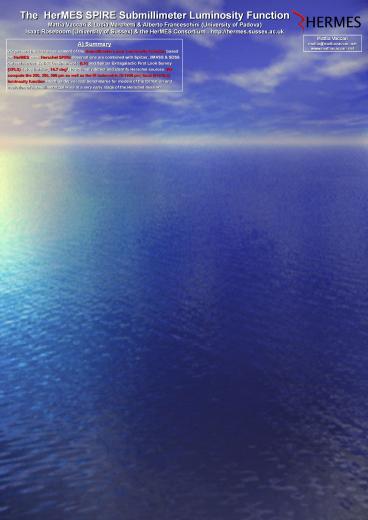The HerMES SPIRE Submillimeter Luminosity Function Mattia Vaccari PowerPoint PPT Presentation
Title: The HerMES SPIRE Submillimeter Luminosity Function Mattia Vaccari
1
The HerMES SPIRE Submillimeter Luminosity
FunctionMattia Vaccari Lucia Marchetti
Alberto Franceschini (University of Padova)Isaac
Roseboom (University of Sussex) the HerMES
Consortium - http//hermes.sussex.ac.uk
AA Herschel Special Issue
AA Herschel Special Issue
http//hermes.sussex.ac.uk
Mattia Vaccari mattia_at_mattiavaccari.net www.mattia
vaccari.net
A) Summary We present the first measurement of
the Submillimeter Local Luminosity Function
based on HerMES data. Herschel SPIRE observations
are combined with Spitzer, 2MASS SDSS datasets
in the SWIRE Lockman Hole (LH) and Spitzer
Extragalactic First Look Survey (XFLS) fields
(totaling 14.7 deg2) to optimally detect and
identify Herschel sources. We compute the 250,
350, 500 µm as well as the IR bolometric (8-1000
µm) local (0ltzlt0.2) luminosity function and thus
derive local benchmarks for models of the
formation and evolution of submillimeter galaxies
at a very early stage of the Herschel mission.
HerMES/Spitzer Large-Area SDP Fields LH XFLS were used in this work HerMES/Spitzer Large-Area SDP Fields LH XFLS were used in this work HerMES/Spitzer Large-Area SDP Fields LH XFLS were used in this work HerMES/Spitzer Large-Area SDP Fields LH XFLS were used in this work
Name Area (deg2) Slim (mJy) 0ltzlt0.2 Sources Total (Spec/Phot)
LH 10 40 478 (369/109)
XFLS 5 30 275 (222/53)
Source s are for the 250 µm sample Flux limits are the same at 350 500 µm Source s are for the 250 µm sample Flux limits are the same at 350 500 µm Source s are for the 250 µm sample Flux limits are the same at 350 500 µm Source s are for the 250 µm sample Flux limits are the same at 350 500 µm
- B) HerMES SPIRE Source Extraction and
Cross-Identification - (Roseboom et al., MNRAS, in preparation)
- At the depth of our SDP imaging there are 1-10
beams/src, significantly below the traditional
confusion limit of 30 beams/src (see Figure 1).
Thus we need to take account of source blending
in performing source photometry and
cross-identification - We achieve this by making use of the strong
correspondence between 24 µm imaging from Spitzer
and the SPIRE bands. The SPIRE fluxes of 24 µm
sources are estimated using a linear inversion
method which finds the best fit set of fluxes
considering the 24 µm positions and the SPIRE
maps (see mat). Similar methods have been used
previously on Spitzer and BLAST data (Magnelli et
al. 2009, Bethermin et al. 2010, Chapin et al.
2010) - Testing on simulations (see Figures 2/3 4)
shows that our method is both reliable and
returns high completeness for even the faintest
SPIRE sources - While our method requires 24 µm detections, we
estimate that in our deepest fields we are
missing at most 15 of the faint SPIRE population
with extreme S250/S24 flux ratios - For local (0ltzlt0.2) sources we estimate to be
complete down to the adopted flux limits
C) Optical/NIR Counterparts SED Fitting
The accurate 24 µm positions used for Herschel
source extraction allows us to reliably determine
the SDSS and 2MASS counterparts of all our
0ltzlt0.2 sources. SDSS, NED and SWIRE follow-up
spectroscopic redshifts are used along with SDSS
photometric redshifts to obtain a complete
redshift information. Archival multi-wavelength
spectrophotometry (including IRAC and MIPS) then
allows us to determine accurate photometric
redshifts and IR luminosities for all 0ltzlt0.2
sources.
D) SPIRE 250, 350, 500 µm IR Bolometric (8-1000
µm) LLF
- We evaluate the Monochromatic IR Bolometric
LLFs using the 1/Vmax estimator - We compare our estimates with models and
measurements from recent literature - (Poisson) errors are estimated in each field and
a weighted mean is then computed
- Testing was performed on two simulated datasets
by taking the mock catalogs of Fernandez-Conde et
al. (2008) and producing maps which match the
observed properties (i.e. noise, PRF) of our
GOODS-N (deep) and LH (shallow) data - Comparisons are performed for the shallow data
between our XID method and two existing
techniques the ubiquitous p-statistic coupled
with Sussextractor derived source catalogues, and
a simpler map-based approach based on Bethermin
et al. (2010) - At 250 µm the HerMES XID method is seen to
clearly outperform the others - At the longer wavelengths the advantage
currently offered by our method is limited
Empty Diamonds Sanders et al. 2003
- F250,350,500 plots black solid line is total
model and color lines are different populations
of Franceschini et al. (2010), dashed black line
is model of Xu et al. (2001), dot-dot-dot-dashed
black line is model of Negrello et al. (2007) - FIR plot dashed, dot-dashed,
dot-dot-dot-dashed and dotted black lines
indicate predictions by Xu et al. (2001), Lagache
et al. (2004), Negrello et al. (2007) and
Valiante et al. (2009), dashed red line is
modified Schechter (double exponential) best fit
- E) Conclusions and future work
- We provide useful local (0ltzlt0.2) benchmarks for
submillimeter galaxy formation and evolution
studies at a very early stage of the Herschel
mission and thus pave the way for wider-area data
soon to be provided by Herschel surveys such as
HerMES and H-ATLAS - Using 24 µm positions and combining linear
inversion and model selection techniques we
reliably detect Herschel sources and identify
them in multi-wavelength images - We find a slightly more abundant local
submillimeter population than predicted by most
models in recent literature and an IR bolometric
(8-1000 µm) LLD of 1.3 108 L? at z0.1 - The continuation of the Herschel mission will
yield larger samples and improved SED templates,
providing better IR bolometric luminosity
estimates and stronger constraints on models for
galaxy evolution and dust emission from the local
to the distant Universe

